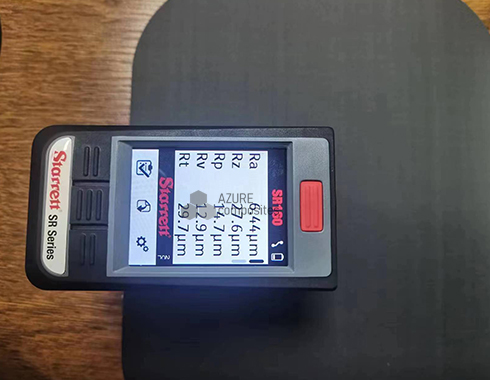The surface roughness of a Pickleball paddle can be tested using the following steps:
- Prepare the equipment: You will need a surface roughness tester, also known as a surface roughness gauge or surface contour meter. This type of instrument can measure the surface roughness of an object and provide accurate measurement results.
- Calibrate the instrument: Place the testing instrument on a level and stable surface, and calibrate it according to the instructions provided in the user manual. Ensure that the instrument reading is accurate.
3. Measure the sample: Place the Pickleball paddle on the support of the testing instrument, and press the test button to start the measurement. The testing instrument will take samples from different positions on the surface of the paddle and calculate the average roughness value.In according with USAPA, they will pick up 6 locations from one side of paddles to gather the different data to analysis.
4. Analyze the results: After the measurement is completed, the testing instrument will display the roughness value of the paddle surface. You can compare these values with the standard requirements to determine if the paddle surface meets the requirements.
It is important to note that the surface roughness of a paddle is related to the personal preference of the player. Some players may prefer a smoother surface on their paddle, while others may prefer a rougher surface. Therefore, when determining if the roughness is appropriate, it is necessary to evaluate it based on the player’s actual usage requirements.
What is difference between RZ and RT?
In according with USAPA, a compatible pickleball paddle must pass the roughness test, it request average RZ reading≤ 30 rz, average RT reading ≤ 40 rt, let’s explain what is difference between RZ and RT?
In surface roughness measurement, the “Rz” and “Rt” parameters both provide information about the roughness of a surface, but they are calculated differently and therefore represent different aspects of roughness.
Rz (also known as the “average roughness depth”) is a measure of the average height difference between the highest peaks and lowest valleys within a sampling length. It is calculated by measuring the vertical distance from the highest peak to the lowest valley over a specific length, typically five sampling lengths. Rz is generally used to assess the overall roughness of a surface.
Rt (also known as the “total roughness”) is a measure of the total height difference between the highest peaks and lowest valleys within a sampling length. It is calculated by measuring the vertical distance from the highest peak to the lowest valley over the entire sampling length. Rt provides information about the range of surface heights within the sampling length, and is useful for assessing the capability of a surface to retain lubricant or coatings, as well as for measuring the depth of surface defects such as scratches and cracks.
In summary, Rz measures the average roughness depth over a specific length, while Rt measures the total height difference between the highest peaks and lowest valleys over the entire sampling length. In regular FAQ, people would ask make the texture finish with .03 to .04 CFS texture, we(Azure pickleball paddles manufacturers) will always transfer them into the same level of RZ or RT.
